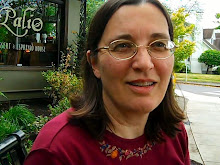My character-driven novel has resisted plotting. Experts who specialize in plotting have thrown up their hands and told me it may not be publishable. Others have suggested an infusion of gunshots or perhaps a car chase.
As I told a friend in a whining e-mail, "The other thing I learned from [unnamed experts] -- which is probably more important than anything they knew they were teaching -- is that it doesn't matter what the experts say. It's the process of telling my story that makes me qualified to tell it. And no matter what I've learned from all my teachers, there comes a time to forget the lessons and ride the wave."
Well, that wave tends to crest and trough, and even a character-driven novel needs a plot. The problem is finding it. The problem, as the unnamed expert pointed out, is to find a destination more concrete than the much-too-nebulous "comes to terms with" or "discovers."
But in a character-driven novel, that outline comes from character development, from beginning to end. Plot points will be physical manifestations of changes in the psyche.
So I've begun a long autobiography of my protagonist, and the milestones begin to emerge from the fog. It's not a plot, but it's the landscape where I'll build my road of a plot.
And the gunshots still are limited to the inciting incident.
As I told a friend in a whining e-mail, "The other thing I learned from [unnamed experts] -- which is probably more important than anything they knew they were teaching -- is that it doesn't matter what the experts say. It's the process of telling my story that makes me qualified to tell it. And no matter what I've learned from all my teachers, there comes a time to forget the lessons and ride the wave."
Well, that wave tends to crest and trough, and even a character-driven novel needs a plot. The problem is finding it. The problem, as the unnamed expert pointed out, is to find a destination more concrete than the much-too-nebulous "comes to terms with" or "discovers."
But in a character-driven novel, that outline comes from character development, from beginning to end. Plot points will be physical manifestations of changes in the psyche.
So I've begun a long autobiography of my protagonist, and the milestones begin to emerge from the fog. It's not a plot, but it's the landscape where I'll build my road of a plot.
And the gunshots still are limited to the inciting incident.

